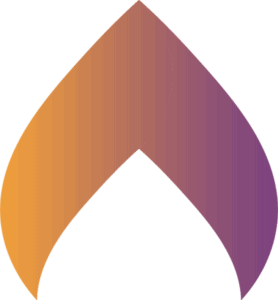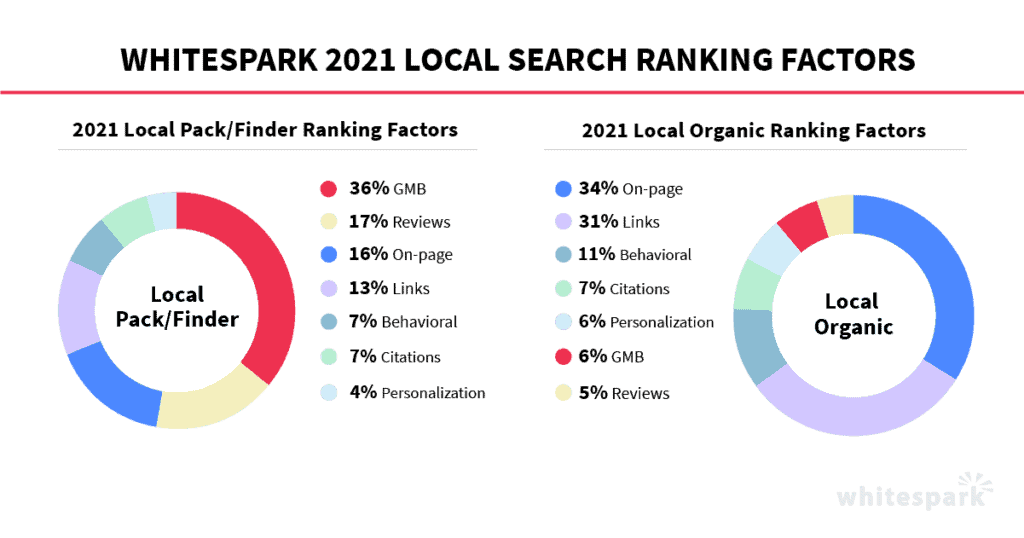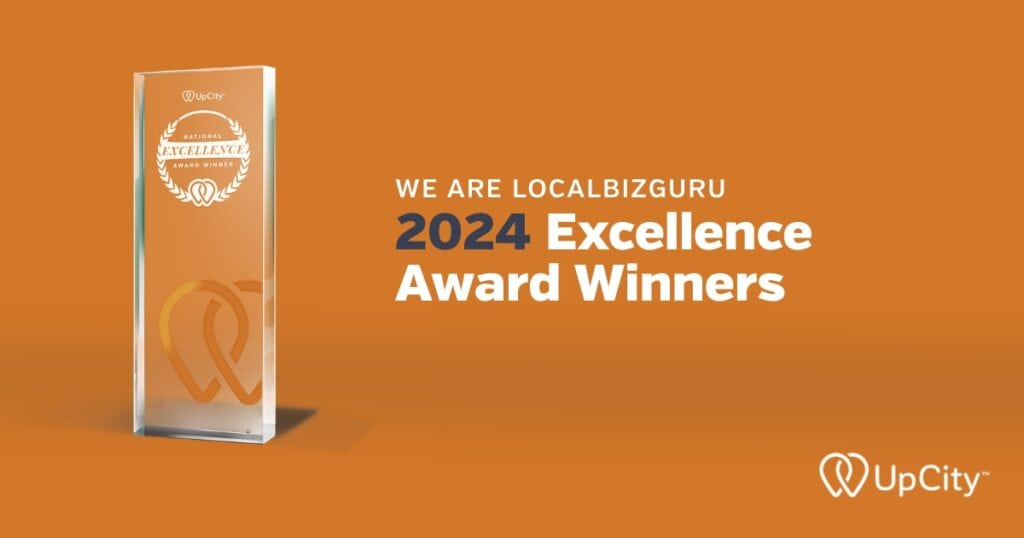

On-Page SEO in 2022 – An Actionable and Effective Guide
Recent Posts
Subscribe Via Email
Updated 3/27/2022
SEO is an important aspect of all marketing strategies, especially if you’re looking to improve your search engine visibility and increase web traffic.
On-page SEO in 2022, in particular, has been shown to boost your organic traffic and help you rank higher in SERPs (search engine result pages) – be it on the local, national, or global level.
On-Page SEO Matters For Local Search
As it pertains to the local side of the equation, On-page SEO is critical to your ranking ability in both the local 3-pack and local organic results!
In fact, in Whitespark’s 2021 Local SEO Ranking Factor Survey, it was found, on-page SEO accounted for an estimated 16% of your ability to rank in the local 3-pack and 34% for local organic results!

The best part is that you don’t need much technical knowledge to execute a strategy for on-page SEO in 2022.
Along with an SEO plugin like Yoast, All In One SEO, or Rank Math, you only need to follow the outlined tips below.
What Is On-Page SEO?
On-page SEO also referred to as on-site SEO and is a type of search engine optimization technique that involves optimizing and formatting the content on your website in a way that makes it understandable and digestible for both search engines and users.
This enables search engines to understand it better, making it easier for them to match your content with your target audience’s queries.
The end result?
On-page SEO in 2022 is crucial as it helps you rank higher on search engines and drive more relevant traffic to your website.
On-Page SEO Checklist:
Top Tips to Increase Your Rankings
1. Know Your Target Audience Deeply
Writing simple content for a general audience may get many reads and shares, but it is often ineffective.
You need to write primarily for your target audience if you hope to increase your conversion rate, and this requires you to have intimate knowledge of their traits.
What is their reading level? What kind of content are they actively looking for? What are their demographic and behavioral traits? Find out as much as you can and then write content that they can relate to. This will improve the quality of your web traffic.
2. Select a Keyword Phrase and Craft the Article Around It

Keywords are the phrases that your target audience uses to look up products and services in your industry. They could either be short-tail keywords (generally one or two words, e.g., ‘shoes’ and are less specific) or long-tail keywords (are usually longer, and more specific e.g., red shoes in X city).
Focus on Search Intent
But don’t just focus on the keywords for the keyword’s sake. Focus on search intent as well.
Understanding what intent is driving the frequency and search volume of a keyword phrase will enable you to craft much more effective content that will capture more leads.
Employ The Use of Tools
Use a keyword research tool to find the best terms to target. There are many effective keyword research tools out there that are free or very inexpensive.
Tools like Keyword Surfer or Keywords Everywhere allow you to do rudimentary keyword research right in your browser!
Once you’ve selected the best keyword phrases for your piece, incorporate the keyword phrase and similar supporting concepts throughout the post.
Try to keep the keyword density at around 2-5% of your text to avoid spam penalties. For instance, an article of 300 words should ideally mention your KW (and related) terms 6 to 15 times.
Make sure the KW phrase is unique for each page on your site. The last thing you want to do is compete with yourself for ranking.
You should incorporate your keyword in:
- the article-headings
- the meta title of the page
- the page’s URL
- the content of the article (especially in the first paragraph)
- the meta-description.
Broaden your content by incorporating semantically related terms. This way, you will still be writing about the same thing, without the risk of being penalized.
3. Keep Your Article at an Optimal Length
Comprehensive content tends to rank highly. Keep your content between 300-700 words for normal blog posts and 2000-3000+ words for pillar pages. If your content is below 200 words, your rankings will tank because search engine bots are often critical of such content.
The truth is, there is no hard & fast rule with regards to word count. The only consideration should be that you need to give your readers useful information that answers any questions they have on the topic.
You accomplish this by writing articles as in-depth as needed that give them a clear idea of what they need to satisfy their query.
4. Break Your Content into Smaller Sections with Headings and Paragraphs
Web users first scan the content before deciding whether they should read it all. If your content is nothing but walls of texts, your bounce rate will be very high, so break up your content into smaller sections to make it easier for people to consume.
Use headings and subheadings to enhance your content’s readability and improve your SEO. Headings enable readers and Google to understand the main topics of a long post while subheadings help your readers navigate your articles by allowing them to scan your page and clarify the content’s structure.
Header Tags (H1, H2, H3, H4, etc.) are used for different sections of your articles and are used by search engine crawlers to determine important content.
Make sure that you use your keywords in some subheadings (but not in each one of them as that makes it unnatural and unreadable).
Generally, H1 tags are reserved for the main page title, while subsequent headings use H2, H3, etc. Write them in order of their priority and hierarchy.
5. Use Internal Links
Your link structure is important for your rankings on search engines. Internal links connect your content to other relevant pages within your website, making it much easier for your website visitors to navigate your site and find all of your content.
They also strengthen your posts and make you seem like an industry expert by showing some authority on the subject. Additionally, internal links ensure that your site gets properly crawled, allowing the search engines to find all of your pages. And of course, your reader could also be interested in these related posts, too.
6. Include Links to External Content
Linking your content to authoritative external sources (high-quality and well-trusted sites) increases your digital footprint and, as Rand Fishkin of Moz.com says, ups “the potential to attract important, relevant, valuable eyeballs when we link.“
However, if you link to unprofessional sites, or those considered simple clickbait, you undermine your credibility and probably hurt your search engine rankings.
Other benefits of backlinks include:
- They can potentially help you build relationships and expand your reach.
- Demonstrates that you care about your readers because you provide them with the resources they need to fully explore the topic by including external links.
- Citing high authority resources and content reinforces to search engines that your site is of high quality and a hub of good information.
7. Update Your Content Regularly & Add Optimized Images
Keep your content fresh and relevant, as this lets the search engine crawlers know that your website is still active. Old content gets your website crawled less often, which then impacts your rankings negatively.
On the other hand, images make the article more visually appealing and increase the rate of social media sharing. (Tweets with images get 150% more retweets than tweets without images!).
To keep your images optimized:
- Compress the image size without compromising image quality.
- Add descriptions and alt text incorporating KWs.
More Tips for On-Page SEO in 2022 Include:
- Using unique and properly formatted titles for the web pages and blog posts, while incorporating the main keyword.
- Including user and search-engine-friendly URLs that are short, memorable, and include targeted keywords, preferably at the beginning of the URL.
- Keeping the title tags under 60 characters to tell visitors and search engines what to expect from the web page. Should include primary KW phrase.
- Including a meta description of 120-150 characters that targets the searched keywords to get people to click on your search engine listing.
Employ These Fundamental, Effective Techniques For On-Page SEO in 2022
The ultimate goal of all SEO strategies is to get your website indexed and ranked highly while providing your target audience with useful information.
On-page SEO increases the crawl-ability of your site, making it easy for search engines to match its content with relevant search queries.
Implement the above tips and techniques to get your on-page SEO in 2022 on point and benefiting your online objectives!
Alternatively, you can work with our SEO gurus to save yourself the trouble.
Feel free to contact us if you are looking to work with top SEO strategists who get results!




